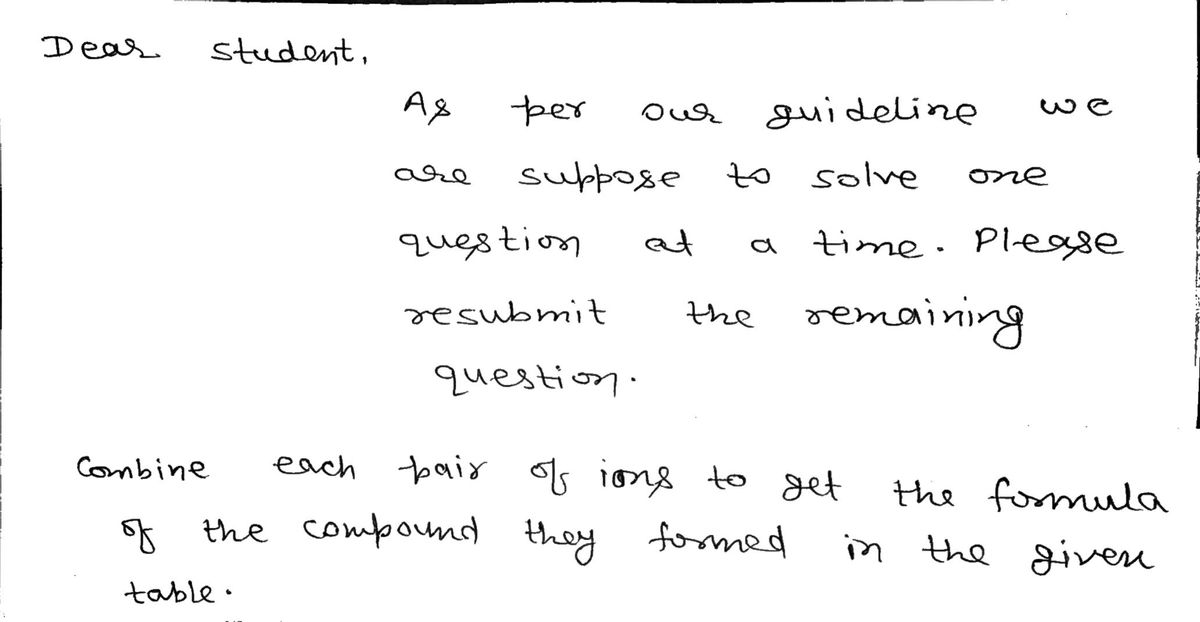Chemistry
10th Edition
ISBN:9781305957404
Author:Steven S. Zumdahl, Susan A. Zumdahl, Donald J. DeCoste
Publisher:Steven S. Zumdahl, Susan A. Zumdahl, Donald J. DeCoste
Chapter1: Chemical Foundations
Section: Chapter Questions
Problem 1RQ: Define and explain the differences between the following terms. a. law and theory b. theory and...
Related questions
Question

Transcribed Image Text:**Chemistry 1120L Report Sheet**
**Combine each pair of ions to get the formula of the compound they form:**
| Cu²⁺ | Cl⁻ |
|------|------|
| Pb⁴⁺ | O²⁻ |
| Li⁺ | N³⁻ |
| K⁺ | CO₃²⁻ |
| Fe³⁺ | S²⁻ |
| Ni²⁺ | PO₄³⁻ |
---
**E. Combine each pair of ions to get the chemical formula, then name the compound:**
| Individual Ions | Compound Formula | Compound Name |
|-----------------|------------------|-------------------|
| Mg²⁺ F⁻ | MgF₂ | magnesium fluoride|
| Al³⁺ P³⁻ | AlP | |
| Co²⁺ NO₂⁻ | | |
| K⁺ CrO₄²⁻ | | |
| Fe³⁺ O²⁻ | | |
---
**F. Give the name for each compound given its chemical formula:**
| Formula | Individual Ions | Name of Compound |
|-----------|-----------------|-------------------|
| CaCl₂ | Ca²⁺ Cl⁻ | calcium chloride |
| K₂S | | |
| FePO₄ | | |
| SnO₂ | | |
| CuBr₂ | | |
| Ag₃N | | |
| Mn(CN)₂ | | |
---
**Explanations:**
- The table in section E is for matching individual ions to form chemical compounds, followed by naming the compound.
- The table in section F requires identifying the individual ions from given chemical formulas and naming the resulting compounds.

Transcribed Image Text:# Naming Compounds Worksheet
## G. Chemical Formulas
Give the chemical formula for each compound given its name:
| Name of Compound | Individual Ions | Formula |
|-----------------------------|-----------------|---------|
| lithium cyanide | Li⁺, CN⁻ | LiCN |
| tin(IV) dichromate | | |
| cadmium nitrite | | |
| copper(II) hypochlorite | | |
| zinc hydrogen carbonate | | |
| lead(II) phosphide | | |
| potassium sulfite | | |
| cobalt(II) selenide | | |
| nickel(II) permanganate | | |
## II. Naming Molecular Compounds
### A. Name the following molecular compounds:
- \( \text{SO}_2 \) = **Sulfur dioxide**
- \( \text{XeF}_4 \) = **Xenon tetrafluoride**
- \( \text{N}_2\text{O}_4 \) = **Dinitrogen tetroxide**
- \( \text{CCl}_4 \) = **Carbon tetrachloride**
- \( \text{IF}_3 \) =
- \( \text{P}_4\text{O}_{10} \) = **Tetraphosphorus decoxide**
### B. Give the formulas for each of the following molecular compounds:
- Phosphorus trichloride = **\( \text{PCl}_3 \)**
- Sulfur tetrafluoride = **\( \text{SF}_4 \)**
- Dinitrogen pentoxide = **\( \text{N}_2\text{O}_5 \)**
### C. Acids
Name each of the following ions, and determine the formula and name of the corresponding acid that forms from the ion:
| Ion Formula | Ion Name | Acid Formula | Acid Name |
|-------------|-----------|--------------|------------|
| \( \text{Br}^- \) | | (aq) = | |
| \( \text{NO}_2^- \) | | (aq) = | |
| \( \text{SO}_4^{2-} \)| | (aq) = | |
|
Expert Solution
Step 1

Step by step
Solved in 3 steps with 3 images

Knowledge Booster
Learn more about
Need a deep-dive on the concept behind this application? Look no further. Learn more about this topic, chemistry and related others by exploring similar questions and additional content below.Recommended textbooks for you

Chemistry
Chemistry
ISBN:
9781305957404
Author:
Steven S. Zumdahl, Susan A. Zumdahl, Donald J. DeCoste
Publisher:
Cengage Learning

Chemistry
Chemistry
ISBN:
9781259911156
Author:
Raymond Chang Dr., Jason Overby Professor
Publisher:
McGraw-Hill Education

Principles of Instrumental Analysis
Chemistry
ISBN:
9781305577213
Author:
Douglas A. Skoog, F. James Holler, Stanley R. Crouch
Publisher:
Cengage Learning

Chemistry
Chemistry
ISBN:
9781305957404
Author:
Steven S. Zumdahl, Susan A. Zumdahl, Donald J. DeCoste
Publisher:
Cengage Learning

Chemistry
Chemistry
ISBN:
9781259911156
Author:
Raymond Chang Dr., Jason Overby Professor
Publisher:
McGraw-Hill Education

Principles of Instrumental Analysis
Chemistry
ISBN:
9781305577213
Author:
Douglas A. Skoog, F. James Holler, Stanley R. Crouch
Publisher:
Cengage Learning

Organic Chemistry
Chemistry
ISBN:
9780078021558
Author:
Janice Gorzynski Smith Dr.
Publisher:
McGraw-Hill Education

Chemistry: Principles and Reactions
Chemistry
ISBN:
9781305079373
Author:
William L. Masterton, Cecile N. Hurley
Publisher:
Cengage Learning

Elementary Principles of Chemical Processes, Bind…
Chemistry
ISBN:
9781118431221
Author:
Richard M. Felder, Ronald W. Rousseau, Lisa G. Bullard
Publisher:
WILEY